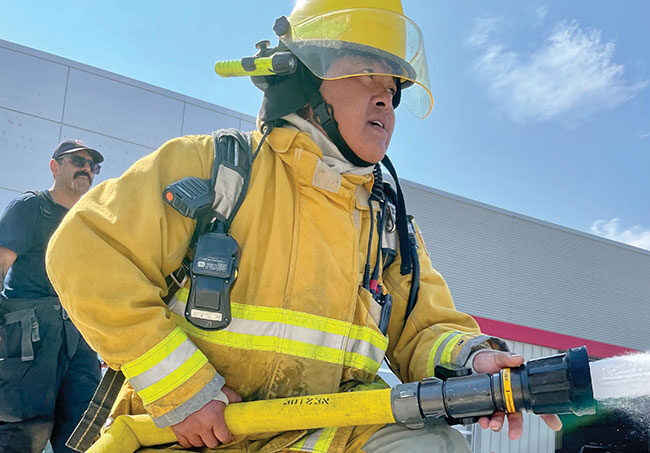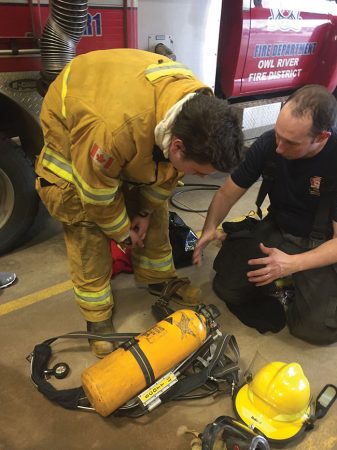
Features
Training
Sub-1001 fire fighting
Training approaches for departments without the resources to be fully NFPA 1001 certified
February 16, 2022
By David Moseley
 A Lac La Biche County Fire Rescue recruit completes their basic training before starting active service. This training covers aspects of NFPA 1001, but not the full standard. Once in active service minimum competencies must be maintained, however NFPA 1001 certification is not mandatory.
A Lac La Biche County Fire Rescue recruit completes their basic training before starting active service. This training covers aspects of NFPA 1001, but not the full standard. Once in active service minimum competencies must be maintained, however NFPA 1001 certification is not mandatory.NFPA 1001 firefighter certification is unquestionably the North American standard for structural firefighters and fire departments. So, why would a fire department choose a lesser standard or no standard at all?
If you started fire fighting in the last decade in an urban setting it might seem baffling that anyone would do this. However, I expect many others will be familiar with the reasons why. While there are well funded volunteer departments with waiting lists to join, others face a constant struggle to attract and maintain members and secure funding. Quite simply these departments may not have the ability to provide 1001 level training and certification, or may be unwilling to place that demand on their members.
Perhaps you think that a little knowledge is a dangerous thing and there is no place for sub-1001 fire fighting. If we were starting from nothing that might be a valid argument. However, many departments are doing their best with very little and to expect them to achieve 1001 or fold is not realistic. Instead of criticizing or ignoring, consider what might be done to improve the situation. Possible approaches to sub-1001 training are extreme triage, 1001 light, or a mixed approach.
Extreme triage is something that can seem impossible. Asking “what are the most essential skills?” may seem like asking who your favourite child is! The best approach might just be to jump in. Starting in a small department in the 1990s, we had no formal training. We were taught two skills and expected to figure out the rest by learning on the job. The two skills taught were running the pump and working in SCBA. Extremely rudimentary, but we were putting out fires. That’s two skills, add firehoses and there is a lot you can achieve. Unsafe? Perhaps, but safer than continuing to fight fire without that much training. Spend a few hours studying fire behaviour and building construction, and you’re that little bit safer still. This is what extreme triage might look like and you can see that unlike full 1001 certification, it is easily achievable for any department. One member or peer from outside the department willing to take on this training can make all the difference.
If a department manages to achieve this, the natural progression is to continue adding skills. Realistically, this may be difficult with low attendance or high turnover, though just starting often creates momentum. This can result in the triage becoming less extreme and move towards what might be described as 1001 light. In this approach, 1001 is the standard and basis for training. It might involve an effort to get as close as possible to all aspects of the standard, or involve a conscious decision to leave out certain specific components. You might reduce your forcible entry finesse to swinging a fire axe, take a pass on class B fires, use only a flat hose load, and defer vehicle extrication to the neighbouring urban department. There is a lot of room to operate between no service at all and that delivered by fully 1001 certified firefighters.

Once a Lac La Biche firefighter in active service minimum competencies must be maintained,
however NFPA 1001 certification is not mandatory.
Then there is a mixed approach. Short of a fully 1001 certified department is one with a mix of 1001 and sub-1001 firefighters. The 1001 training and certification is provided and encouraged, but not mandatory. You might use ICS terminology and type firefighters as Type 1-interior firefighters and Type 2-exterior or support firefighters. This works well for our department where our rural stations may not be able to staff a full roster of 1001 firefighters, but are quicker on scene. They can get started and put the pieces in place for a more aggressive interior attack when more resources from the urban stations arrive. With our stations well integrated, it also allows any individual 1001 firefighter from those rural stations to work at that level when the call response has been elevated. Another benefit to this approach is allowing a transition to a fully 1001 certified department while accommodating existing members unwilling or unable to meet the 1001 standard. This is not only a safe and efficient way to operate, but also respectful.
So far, we have approached this from within an operational box. What about prevention? It helps our humility to remember how much more effective a $20 smoke detector is than a 1001 certified firefighter at saving lives. Keep in mind that you can potentially deploy a much wider pool of volunteers to deliver a prevention program.
Of course, lots of volunteer departments are fully 1001 certified and this should be the goal in many instances. And if you’re reading this magazine, you know it doesn’t stop there. Look at the work done by the Fire Safety Research Institute in furthering our knowledge of fire behaviour, or the International Association of Fire Fighters on firefighter survival. This magazine is a wonderful resource for continuous learning that exceeds the 1001 standard. But at the same time, let’s not neglect those in our ranks who are more challenged to meet the enormous demands placed on our shoulders. The suggestions here can offer a realistic and immediate course to establish a safer base, and from there potentially full 1001 certification in the future.
David Moseley is a forest officer with the Government of Alberta, and officer with Lac La Biche County Fire Rescue in Alberta, focused on operations. His other areas of interest include instructing, CISM and wildfire investigation. Contact him at david.moseley@gov.ab.ca
Print this page